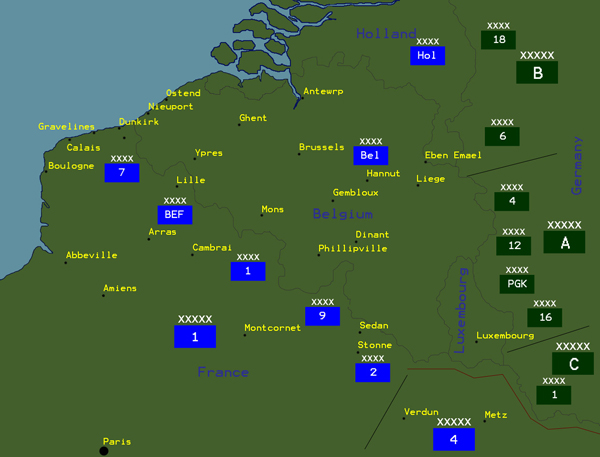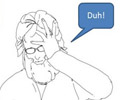The Second World War - Order Of Battle - World War Two - Battle Of France
The Opposing Armies
For the Offensive in the West the Germans had 136 divisions at their disposal. The Germans had just completed the subjugation of Poland, their troops had battle experience and they knew what they could and couldn't do with their equipment.
The French on paper was the best army in the world. France deployed 94 divisions on its northern borders with Germany and Belgium. It was in reality very short of manpower; a low birthrate and the losses of the First World War had made a massive negative impact on the population of France. Added to this were 22 Belgian divisions, 10 Dutch divisions and 10 British divisions.
The Germans had around 2,400 tanks against about 3,000 that the Allies possessed. The German tanks, however, were grouped into self contained armoured units that included mobile infantry, artillery and support units. The Allied tanks were mainly dispersed amongst the infantry units apart from a few new armoured divisions. The Allied tanks, were on aggregate, better armed and better protected but some had only a four man crew, which tended to put the commander under too much strain during combat, having to load the gun and direct the tank at the same time.
The Germans possessed two fighters: the Messerschmitt bf109e and the Messerschmitt bf110 twin engine heavy fighter. These were better than anything the Allies possessed except the British Hawker Hurricane, which was slightly inferior to the bf109e but more than a match for the bf110. The German air force, the Luftwaffe, was integrated with the army to provide support and had practiced this role in Poland.
A critical factor in the forthcoming campaign was communications. German tanks each had a radio that allowed the units to act in a co-ordinated manner, controlled by a mobile headquarters. German units also had air units at their disposal that, using radio, could be called into action to overcome any stiff resistance within 45 minutes or so. As few as one fifth of the Allied tanks had radios. This gave the German army a huge advantage and allowed them to dictate the battle to their benefit.

The French and German armies faced each other across the neutral Low Countries in May 1940
Allied Order of Battle
The Allied command was divided into three army groups, the independent British contingent being under the nominal command of the French First Army Group. The First Army Group was responsible for the line from the end of the Maginot line to the Channel coast; this army group would bear the brunt of the German offensive. The Second army Group and Third Army Group were responsible for covering the Maginot line.
| First Army Group | 7th Army | 21st Infantry Division | |
| (Giraud) | 60th Infantry Division | ||
| 68th Infantry Division | |||
| 1st Corps | 1st Light Mechanised Division | ||
| 25th Motorised Division | |||
| 16th Corps | 9th Motorised Division | ||
| BEF | 5th Infantry Division | ||
| (Gort) | 12th Infantry Division | ||
| 23rd Infantry Division | |||
| 46th Infantry Division | |||
| I Corps | 1st Infantry Division | ||
| 2nd Infantry Division | |||
| 48th Infantry Division | |||
| II Corps | 3rd Infantry Division | ||
| 4th Infantry Division | |||
| 50th Infantry Division | |||
| III Corps | 42nd Infantry Division | ||
| 44th Infantry Division | |||
| 1st Army | Cavalry Corps | 2nd Light Mechanised Division | |
| (Blanchard) | 3rd Light Mechanised Division | ||
| 3rd Corps | 1st Moroccan Infantry Division | ||
| 2nd North African Infantry Division | |||
| 4th Corps | 32nd Infantry Division | ||
| 5th Corps | 5th North African Infantry Division | ||
| 101st Infantry Division | |||
| 9th Army | 4th North African Infantry Division | ||
| (Corap) | 53rd Infantry Division | ||
| 2nd Corps | 4th Light Cavalry Division | ||
| 5th Motorised Division | |||
| 11th Corps | 1st Light Cavalry Division | ||
| 18th Infantry Division | |||
| 22nd Infantry Division | |||
| 41st Corps | 61st Infantry Division | ||
| 102nd Fortress Division | |||
| 3rd Spahi Brigade | |||
| 2nd Army | 2nd Light Cavalry Division | ||
| (Huntzinger) | 5th Light Cavalry Division | ||
| 1st Cavalry Brigade | |||
| 10th Corps | 3rd North African Infantry Division | ||
| 5th Light Cavalry Division | |||
| 55th Infantry Division | |||
| 71st Infantry Division | |||
| 18th Corps | 1st Colonial Infantry Division | ||
| 41st Infantry Division | |||
| Belgian Army | I Corps | 1st Infantry Division | |
| 4th Infantry Division | |||
| 7th Infantry Division | |||
| II Corps | 6th Infantry Division | ||
| 11th Infantry Division | |||
| 14th Infantry Division | |||
| III Corps | 1st Chasseurs Ardennais | ||
| 2nd Infantry Division | |||
| 3rd Infantry Division | |||
| IV Corps | 9th Infantry Division | ||
| 15th Infantry Division | |||
| 18th Infantry Division | |||
| V Corps | 12th Infantry Division | ||
| Second Army Group | 3rd Army | 3rd Light Cavalry Division | |
| 6th Infantry Division | |||
| 6th North African Infantry Division | |||
| 6th Colonial Infantry Division | |||
| 7th Infantry Division | |||
| 8th Infantry Division | |||
| Colonial Corps | 2nd Infantry Division | ||
| British 51st (Highland) Infantry Division | |||
| 56th Infantry Division | |||
| 6th Corps | 26th Infantry Division | ||
| 42nd Infantry Division | |||
| 24th Corps | 51st Infantry Division | ||
| 42nd Corps | 20th Infantry Division | ||
| 58th Infantry Division | |||
| 4th Army | Polish 1st Infantry Division | ||
| 45th Infantry Division | |||
| 9th Corps | 11th Infantry Division | ||
| 47th Infantry Division | |||
| 20th Corps | 52nd Infantry Division | ||
| 82nd African Division | |||
| 5th Army | 44th Infantry Division | ||
| 8th Corps | 24th Infantry Division | ||
| 31st Infantry Division | |||
| 12th Corps | 16th Infantry Division | ||
| 35th Infantry Division | |||
| 70th Infantry Division | |||
| 17th Corps | 62nd Infantry Division | ||
| 103rd Infantry Division | |||
| 43rd Corps | 30th Infantry Division | ||
| Third Army Group | Eighth Army | 7th Corps | 13th Infantry Division |
| 27th Infantry Division | |||
| 13th Corps | 19th Infantry Division | ||
| 54th Infantry Division | |||
| 104th Infantry Division | |||
| 105th Infantry Division | |||
| 44th Corps | 67th Infantry Division | ||
| 45th Corps | 57th Infantry Division | ||
| 63rd Infantry Division | |||
| Polish 2nd Infantry Fusiliers Division | |||
| Dutch Army | Light Division | ||
| I Corps | 1st Infantry Division | ||
| 3rd Infantry Division | |||
| II Corps | 2nd Infantry Division | ||
| 4th Infantry Division | |||
| III Corps | 5th Infantry Division | ||
| 6th Infantry Division | |||
| IV Corps | 7th Infantry Division | ||
| 8th Infantry Division | |||
German Order of Battle
For Fall Gelb the German forces were organised into three army groups: Army Group B to create a diversionary attack in the north to lure the allies into the Low countries and Belgium; Army Group A to exploit the weakness in the allied center and slice through the rear of the allies in the Low Countries and Army Group C to pin the French armies in the Maginot Line.
| Army Group A | 4th Army | II Corps | 12th Infantry Division |
| 32nd Infantry Division | |||
| V Corps | 211th Infantry Division | ||
| 251st Infantry Division | |||
| 263rd Infantry Division | |||
| VIII Corps | 8th Infantry Division | ||
| 28th Infantry Division | |||
| 87th Infantry Division | |||
| 267th Infantry Division | |||
| XV Corps | 5th Panzer Division | ||
| 7th Panzer Division | |||
| 62nd Infantry Division | |||
| 12th Army | III Corps | 3rd Infantry Division | |
| 23rd Infantry Division | |||
| 52nd Infantry Division | |||
| VI Corps | 16th Infantry Division | ||
| 24th Infantry Division | |||
| XVIII Corps | 1st Mountain Division | ||
| 5th Infantry Division | |||
| 21st Infantry Division | |||
| 25th Infantry Division | |||
| 16th Army | VII Corps | 36th Infantry Division | |
| 68th Infantry Division | |||
| XIII Corps | 10th Infantry Division | ||
| 15th Infantry Division | |||
| 17th Infantry Division | |||
| XXIII Corps | 26th Infantry Division | ||
| 34th Infantry Division | |||
| 58th Infantry Division | |||
| 76th Infantry Division | |||
| Panzer Group Kleist | XIV Corps | 2nd Infantry Division (mot) | |
| 13th Infantry Division (mot) | |||
| 29th Infantry Division (mot) | |||
| XIX Corps | 1st Panzer Division | ||
| 2nd Panzer Division | |||
| 10th Panzer Division | |||
| XXXXI Corps | 6th Panzer Division | ||
| 8th Panzer Division | |||
| Reserve | XXXX Corps | 4th Infantry Division | |
| 6th Infantry Division | |||
| 9th Infantry Division | |||
| 27th Infantry Division | |||
| 71st Infantry Division | |||
| 73rd Infantry Division | |||
| Army Group B | 6th Army | XVI Corps | 4th Infantry Division |
| 33rd Infantry Division | |||
| 3rd Panzer Division | |||
| 4th Panzer Division | |||
| IV Corps | 15th Infantry Division | ||
| 205th Infantry Division | |||
| XI Corps | 7th Infantry Division | ||
| 31st Infantry Division | |||
| 211th Infantry Division | |||
| 253rd Infantry Division | |||
| IX Corps | |||
| XXVII Corps | 253rd Infantry Division | ||
| 269th Infantry Division | |||
| 18th Army | SS 'Verfugungstruppe' Division | ||
| 7th Airborne Division | |||
| 22nd Air Landing Infantry Division | |||
| 9th Panzer Division | |||
| 207th Infantry Division | |||
| Reserves | 208th Infantry Division | ||
| 225th Infantry Division | |||
| 526th Infantry Division | |||
| X Corps | SS 'Adolf Hitler' Regiment | ||
| 227th Infantry Division | |||
| 1st Cavalry Division | |||
| XXVI Corps | 256th Infantry Division | ||
| 254th Infantry Division | |||
| SS 'Der Fuhrer' Division | |||
| Army Group C | 1st Army | XII Corps | |
| XXIV Corps | |||
| XXX Corps | |||
| XXXVII Corps | |||
| 7th Army | XXV Corps | ||
| XXXII Corps | |||
Italian Order of Battle
The Italians came into the Battle of France as it was about to draw to a close. Mussolini intended to take advantage of the French defeat but his forces were held up in the Alps by the French.
| Italian Army | 1st Army | 2nd Corps | |
| 3rd Corps | |||
| 15th Corps | |||
| 4th Army | 1st Corps | ||
| 4th Corps | |||
| Alpine Corps |
